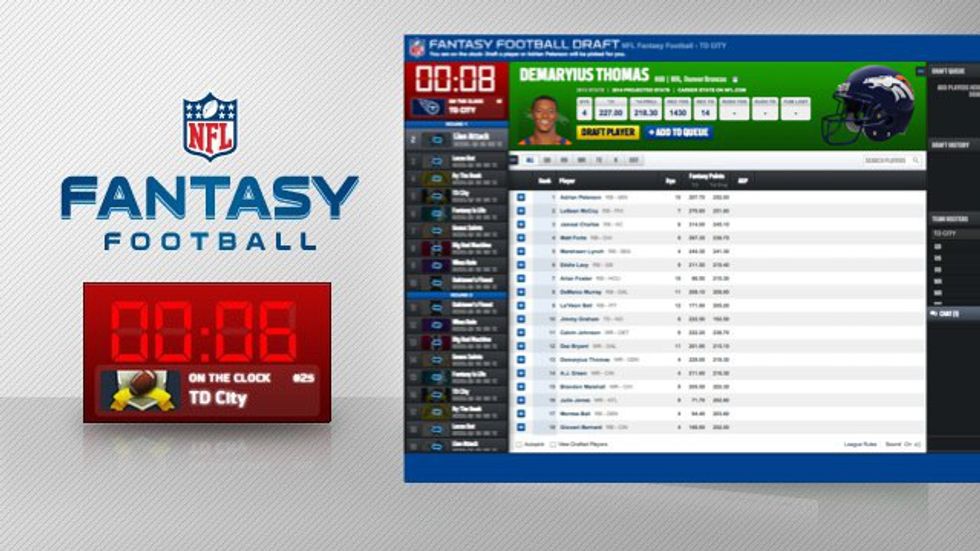We are on the cusp of September, and football awaits us. We've crawled through the grimy narrow tunnel of spring and summer, fending off the cool of March and blazing all the way through to the August haze, and we're so close to the finish line. The NFL has begun its preseason games and that only means one thing: fantasy football is back. Many of you, like myself, have been playing fantasy football for quite some time and understand the ins and outs of it. Others, however, may be new to it completely and are wondering how it's done and how one can learn so much in such little time. Well, I'm going to lend a helping hand. For those who are new to fantasy football, I'm going to give you a brief and basic drafting strategy that could benefit you for your first fantasy season. This article, mind you, will be part one of two. This particular article will briefly explain the basic and most commonly used draft scheme (draft order) and then dive in depth into the two different point systems and how they work both positively and negatively. Next week's article will be the meat on your plate, the in-depth strategic methods to be used when you finally begin drafting your fantasy team. Let's begin.
To begin, you'll need to know the kind of draft you'll be participating in. In some leagues, the manager of the league may decide to customize the order of the draft, at which point you will be picking at the same spot throughout the entire process. The most commonly used draft order is known as a snake draft, which I will use as an example when I break down my strategies. The snake draft functions as follows: it reverses the order of the draft each round. For example, let's say in the first round, you're the first overall pick. This means that in round two, you'll then be the tenth overall pick, and you'll return to the first overall pick when round three begins. This process is continued until the draft is complete.
Secondly, you need to be familiar with what kind of points system you'll be part of. The points system is key for picking a strategy. The two most common systems are Standard Points and PPR (Points per Reception). These are the two that I will be discussing in this article. The difference between the two is simple: the standard points system awards points for positive yardage and touchdowns and deducts points for poor play such as an interception thrown, a fumble, or lost yardage. The PPR system is exactly the same with one small but definitive exception: it gives an extra point for each reception made by an offensive player.
Next, you'll want to be familiar with the positions used in fantasy football. Standard fantasy football leagues and PPR leagues only use offensive players, one special team's player, and one defensive unit as a whole. The positions for the roster are as follows: one quarterback, two running backs, two wide receivers, one tight end, one flex (an extra position of either a wide receiver or running back, solely your choice), a kicker and the defensive unit. Each position will render you points, and to understand where the meat of the points comes from is key. This is the easiest part of the entire draft strategy, and I'm going to answer that one in the next paragraph.
The points are earned differently for each position, and while they can be a game changer depending on which athletes you have on your team, they can equally be damning if mistakes are made. The bulk of your team is going to be found in the running backs and wide receivers, and this reigns true in both a standard points league and a PPR league. Each wide receiver, tight end, and running back accrue one point per ten yards gained. So, let's say you have a wide receiver who finishes a game with one hundred yards, that means he's earned you ten points. The same holds true for a running back and wide receiver. Quarterback points are similar, except points are gained for every yard thrown, and you gain one point per every fifteen yards. If your quarterback throws for 270 yards, that would translate to eighteen points.
Rushing touchdowns and receiving touchdowns are the same number of points: six. For example, let's say your running back ran for a ten-yard touchdown. The touchdown earns you six points and the ten yards earn you an additional point, a total of seven points. Quarterbacks earn four points per touchdown. If a quarterback ends a game with three passing touchdowns, that will be a total of twelve points via touchdowns. If a quarterback runs for a touchdown, he earns six points.
The points system for a kicker is determined on the distance of the field goal. While any extra points made by the kicker will always render a single point, the distance of the field goal will earn you more points. A kicker that makes a fifty-yard field goal earns more points than a twenty-yard field goal. I can't say for certain how many points a kicker would earn in such a situation, as many fantasy leagues change the number of points earned for a kicker and even the defensive unit.
As mentioned, each position could retract any earned points throughout the game. If your quarterback throws an interception, or a wide receiver fumbles the football, or if the defense allows too many yards to the offense, these will result in negative points for your team. For this reason, amongst many others, it would be good to do some research on the athletes in the NFL and become familiar with their reputation and how they rank in the fantasy world. Every player is ranked in whatever fantasy site you decide to use. Log onto ESPN or NFL.com (if you use those sites) and go to your fantasy home page and begin by looking for the pre-draft rankings. Each player is ranked highest to lowest for their respective positions. This will give you insight on players to watch and who to draft when your turn comes along. But be weary, the more popular the player, the less of a chance they'll be available in the draft early on.
Well, that concludes part one of fantasy strategies 101. Now that you've read this article, begin familiarizing yourself with some of the bigger names in the NFL, and check back next week for the blueprints of a championship fantasy football team. Good luck to everyone!




 Photo by
Photo by 














